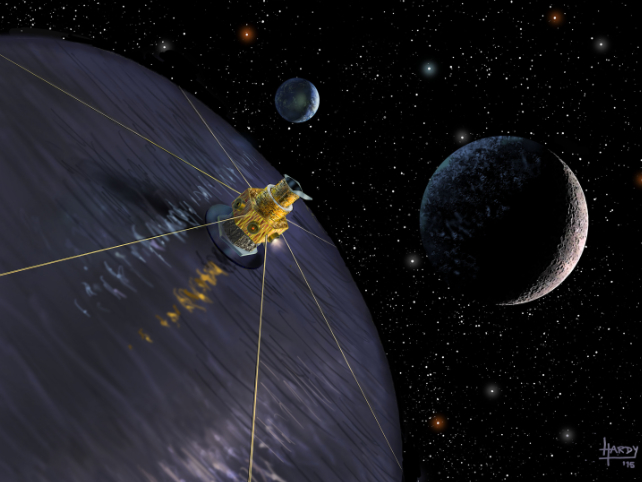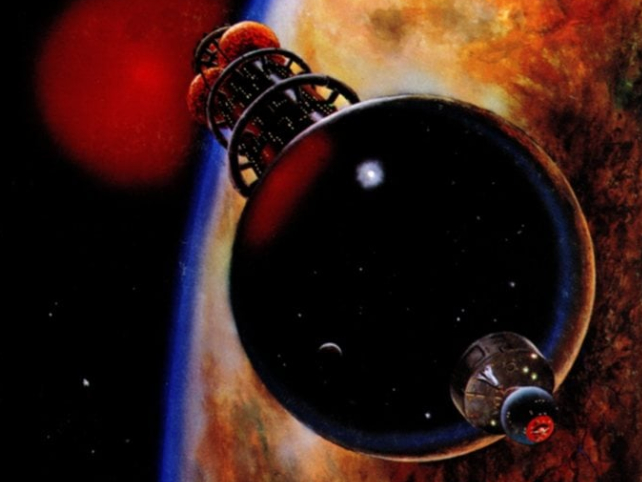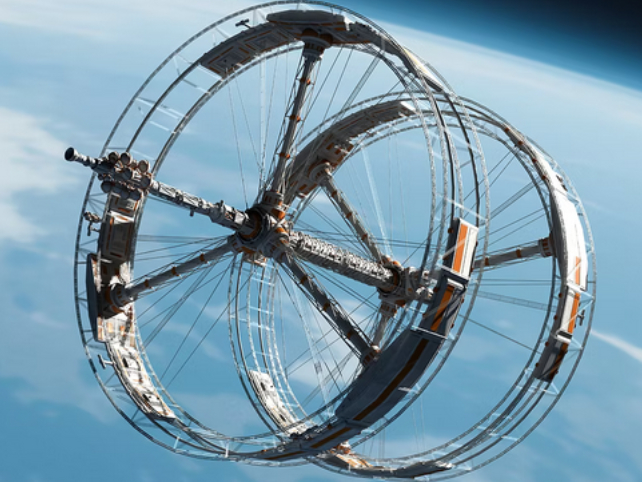On November 1st, 2024, Project Hyperion – an international, interdisciplinary team of architects, engineers, anthropologists, and urban planners – launched a design competition for crewed interstellar travel.
The event was hosted by the Initiative for Interstellar Studies (i4is), a UK-based non-profit organization dedicated to the robotic and human exploration of exoplanets around nearby stars, and eventually settlement. With a prize purse of $10,000, competitors were tasked with producing concepts for a Generation Ship (aka. worldships) using current technologies and those that could be realized in the near future.
On 23 July, 2025, the organization announced the top three competition winners, which were selected from hundreds of ideas submitted by teams worldwide. The winning entries were selected based on how they met all the competition criteria, provided a depth of detail, and integrated the design aspects of architecture, engineering, and social sciences.
Related: The Radical Plan to Build a Spaceship to Carry Humans For Generations
In short, the top three prizes were awarded to proposals that would allow a society to sustain itself and flourish in a highly resource-constrained environment as they made a centuries-long journey to another habitable planet.
The challenges and hazards of space exploration are well-known and well-documented, ranging from long-duration transits, exposure to radiation, the amount of supplies needed, and the dangers of being cooped up inside a pressurized ship in close quarters with other crew members.
As the saying goes, "space is hard," but interstellar travel is especially difficult and dangerous. Not only are resupply missions not an option for missions venturing so far beyond Earth, but the time and energy it would take for spacecraft to travel to even the nearest star is prohibitive.

Generation ships
As we addressed in a previous post, it would take 1,000 to 81,000 years to reach the nearest star (Alpha Centauri) using current or technologically-feasible propulsion methods.
At present, the only method for travelling from one star system to the next within a human lifetime is directed-energy propulsion, where gram-scale watercraft equipped with lightsails are accelerated by laser arrays to relativistic speeds (a fraction of the speed of light). Proposed concepts include Breakthrough Starshot and Swarming Proxima Centauri, both of which grew from Project Dragonfly, a feasibility study conducted by i4is in 2015.
Since the early Space Age, several methods have been proposed for sending crewed missions to nearby stars within a reasonable amount of time (a few years to a few dozen). However, these methods are either prohibitively expensive, require significant technological advances, the discovery of new physics, or a combination thereof.
The only alternative is to develop ships that accommodate crews for the long journey, which means spacecraft that have bioregenerative life support systems (BLSS) and the necessary equipment for growing food, recycling water and air, and enough room for multiple generations to live and grow.
The concept has been explored through science fiction and feasibility studies since the early 20th century. The earliest known example was in the 1918 essay The Ultimate Migration by Robert H. Goddard, one of the "forefathers of rocketry" and for whom NASA's Goddard Space Flight Center is named.
Per his proposal, the ship would be powered by atomic energy or a combination of hydrogen/oxygen fuel and solar energy, while the crew would spend the journey in suspended animation.
Konstantin E. Tsiolkovsky, another "forefather of rocketry," also addressed the idea of a multi-generational spaceship in his essay The Future of Earth and Mankind (1928). In it, he described a self-sufficient "Noah's Ark" where crews were kept in wakeful conditions until they reached their destination thousands of years later.
J. D. Bernal (inventor of the "Bernal Sphere") provided an early description of a generation ship in the 1929 essay The World, The Flesh, & The Devil, which addressed human evolution and its future in space.
In 1946, Polish-American mathematician Stanislaw Ulam (a contributor to the Manhattan Project) proposed how nuclear devices could be repurposed for space exploration – known as Nuclear Pulse Propulsion (NPP).
In 1955, NASA launched Project Orion, a joint study by Freeman Dyson from the Institute for Advanced Study and General Atomics to investigate NPP for interstellar travel. The project was abandoned in 1963 after the signing of the Limited Test Ban Treaty, which enforced a permanent ban on nuclear testing in Earth orbit.

This was followed by Dr. Robert Enzmann's proposal in 1964, which was the most detailed description of a generation ship to date. This "Enzmann Starship" would measure 600 meters (2000 feet), accommodate an initial crew of 200 (with room for expansion), and rely on deuterium fuel and fusion reactions to achieve relativistic speeds.
The British Interplanetary Society (BIS) conducted a feasibility study for interstellar travel known as Project Daedalus in the 1970s, which called for a two-stage fusion-powered spacecraft that would make the trip to Barnard's Star (5.9 light-years from Earth) in a single lifetime.
While this concept was for an uncrewed spacecraft, it would go on to inform Project Icarus, a crewed version of the concept launched by the BIS and the Tau Zero Foundation in 2009.
In recent years, the NASA Institute for Advanced Concepts (NIAC) has researched antimatter propulsion for long-duration space missions. This method involves collisions between hydrogen and antihydrogen atoms and offers the benefits of incredible energy density and low mass.
Between 2017 and 2019, Dr. Frederic Marin of the Astronomical Observatory of Strasbourg conducted a series of highly detailed studies using a new type of numerical software (called HERITAGE) that they created themselves. These studies considered all the necessary parameters for a generation ship, including minimum crew size, genetic diversity, and the size of the ship.
The winners
The participating teams were interdisciplinary and required at least one architectural designer, engineer, and social scientist (sociologist, anthropologist, etc.). Each team was tasked with creating ships that featured self-sustaining ecosystems, featuring agriculture, habitation, and other necessary life-support systems to ensure survival across multiple generations.
Per the competition rules, these ships needed to provide:
- Habitability for 1,000 ± 500 people over centuries
- Artificial gravity via rotation
- A society that ensures good living conditions, including essential provisions such as shelter, clothing, and other basic needs.
- Robust life support systems for food, water, waste, and the atmosphere
- Knowledge transfer mechanisms to retain culture and technologies
Moreover, their spacecraft concepts needed to demonstrate how they might achieve a maximum velocity of 10% the speed of light (0.1 c), making it to the nearest habitable exoplanet – Proxima b, located about 4.25 light years from Earth – in about 250 years.
The following entries earned the top three prizes:
1st Place: Chrysalis
The Chrysalis team hails from Italy and included Giacomo Infelise, an architect and landscape designer; Veronica Magli, an economic scientist and innovator; Guido Sbrogio, an astrophysicist and engineer; Nevenka Martinello, an environmental engineer and freelance artist; and Federica Chiara Serpe, a psychologist, actress, and artist.
Their ship design consisted of a modular cylindrical structure that minimizes the front section, thereby reducing the threat of Micrometeoroids and Orbital Debris (MMOD) collisions and reducing structural stresses during the acceleration and deceleration phases.

The ship measures 58,000 meters (63,430 yards) from end to end and 6,000 m (6,560 yards) in diameter and has a total mass of 2.4 billion metric tons (2.65 US tons). The spacecraft uses a Direct Fusion Drive (DFD) propulsion system and Helium-3 (3He) and deuterium (2H or D) fuel to generate 0.1 g (0.98 m/s2) of acceleration.
After an acceleration period lasting one year, the designers anticipate a journey of at least 400 years, followed by a year of deceleration once they are within reach of Proxima b.
The habitat, contained in the forward section, has a coaxial rotary structure, consisting of nested levels that include (from the outer to inner level) food production and ecosystems, communal spaces, dwellings and gardens, facilities, a warehouse level, and the axial core.
Each shell rotates continuously throughout the journey to simulate Earth-like gravity and provide all the necessary housing, infrastructure, energy, and resources to sustain its crew of about 600 inhabitants. At the fore of the ship is the Cosmo Dome, which allows passengers to view the cosmos while recreating in low gravity.
The design also comes with the option of an alternate rotation system to reduce perturbation, where odd-numbered shells rotate clockwise and even-numbered shells rotate counterclockwise. As the i4is indicated in their news release:
Chrysalis impressed the jury with its system-level coherence and innovative design of the modular habitat structure but also overall depth of detail, which included, for example, in-space manufacturing and the value of pre-mission crew preparation in Antarctica.
Its modular shell design promotes flexibility and connectivity, supporting both functionality and scalability. The large Dome structure adds a dramatic, cinematic quality that evokes science fiction classics, while the overall system-level planning – covering not just architecture but also how to build the vessel – is notably strong.
2nd Place: WFP Extreme
Team WFP Extreme was made up of architects, designers, and scientists from the Design for Extreme Environments Studio at the Faculty of Industrial Design (Design for Extreme Environments Studio) in Krakow.
The team was mentored by Dr hab. Michał Kracik, the leader of the DEES and an Adjunct Professor in the Department of Design Methodology who conducted research related to spacesuit design at the Massachusetts Institute of Technology (MIT).
Their spacecraft consists of a central core and two counterrotating rings that provide simulated gravity while the counter-rotation minimizes Coriolis effects. Each ring measures 500 meters (~550 yards) in diameter and contains living quarters, workspaces, and social areas divided into six neighborhoods (three per ring).

The core houses the ship's hydroponic farms, energy systems, and control stations and is connected to the rings through a series of structural arms with elevators. The six neighborhoods are connected by a running track and a pedestrian walkway, while the elevators to the core allow for transportation between rings, allowing for interaction and cultural exchanges between the different communities.
According to the jury, this concept was "[c]ommended for overall excellence" for the following reasons:
WFP Extreme has a particularly strong focus on cultural and societal dimensions, including concepts like clothing and spiritual spaces. It excels in its cultural and societal considerations, offering some of the most thoughtfully developed ideas in this area.
The architectural design introduces advanced technologies such as radiation protection and demonstrates creative touches like the "taxi capsule" and personalized crew clothing.
3rd Place: Systema Stellare Proximum
The third-place winning team consisted of Dr. Philip Koshy, a Professor of Mechanical Engineering at McMaster University; physician and medical specialist Jan Johan Ipe, and graphic designer Amaris Ishana Mathen.
Their concept is the Systema Stellare Proximum, a starship with two counterrotating Stanford Torii within a hollowed-out asteroid core. The ship has a quantum-AI navigation system and would initially use Nuclear Pulse Propulsion before switching to ion propulsion in its secondary stage. As they describe it in their proposal:
The year is 2320. Mankind has fully transformed [into] a space-based economy and has conquered the Solar System. Humans as a species have advanced science to the point that we are ready to embark on interstellar exploration.
The interstellar railroad would be more than just a technological marvel - it would mark a historic turning point in human migration, one that begins in earnest after 2080.
The first deep space missions involving sentient beings will commence, initially focusing on capturing or harvesting nearby asteroids for resources and developing waves of robotic probes to set towards Proxima Centauri-b.
Their design is an example of "biomimicry" and is loosely based on the evolutionary traits of a jellyfish to reduce the risks associated with deep space travel. This includes using an asteroid shell shaped like a bell, similar to a jellyfish's head (or "bell"), which acts as a shield and protects against radiation and impacts.
The leading edge of the asteroid is composed of materials with varying densities, similar to jellyfish bells, to dissipate energy from impacts. The shield is also equipped with self-healing technologies and robots on its surface that constantly repair damaged sections.
Another example of biomimicry is the pulsed plasma ion propulsion system that is inspired by the pulsing motion of a jellyfish's tentacles. The ship also relies on a swarm of tethered drones using electrostatic propulsion to maneuver or anchor it in position when required.
The starship also incorporates an integrated network of sensors across its surface that provide situational awareness, identify potential resources (or technosignatures), and detect micrometeoroid impacts, radiation levels, and other environmental hazards. This is complemented by adaptive navigation systems that use this sensor data to make trajectory adjustments.
The internal habitat is a modular system similar to that found in some species of jellyfish that allows for expansion and reconfiguration. The life support system is closed-loop and bioregenerative, using algae or other microorganisms to convert waste into food and oxygen.
In addition, the starship incorporates hydroponic/aquaponic systems for supporting fish populations (a lean source of protein and fatty acids) and purifying water. Lastly, the ship employs a laser-based defense system that targets and vaporizes micrometeoroids too small to be blocked by the asteroid shield. Per the jury's evaluation:
Systema Stellare Proximum distinguishes itself by its immersive storytelling, seamlessly tying together technical, social, and cultural aspects. This concept delivers a rich and imaginative narrative that thoughtfully weaves together social, technical, and cultural aspects of long-term space habitation.
Its storytelling is engaging, with creative scenarios that explore community dynamics and even spirituality—emphasizing the role of shared values in building resilient, intergenerational societies.
The use of an asteroid as a radiation shield is a bold and compelling strategy, paired with a visually striking structure inspired by the form of a jellyfish.
In addition to the top three entries, many submissions earned honorable mentions.
Check out the Project Hyperion website for the full list of winning submissions.
This article was originally published by Universe Today. Read the original article.
